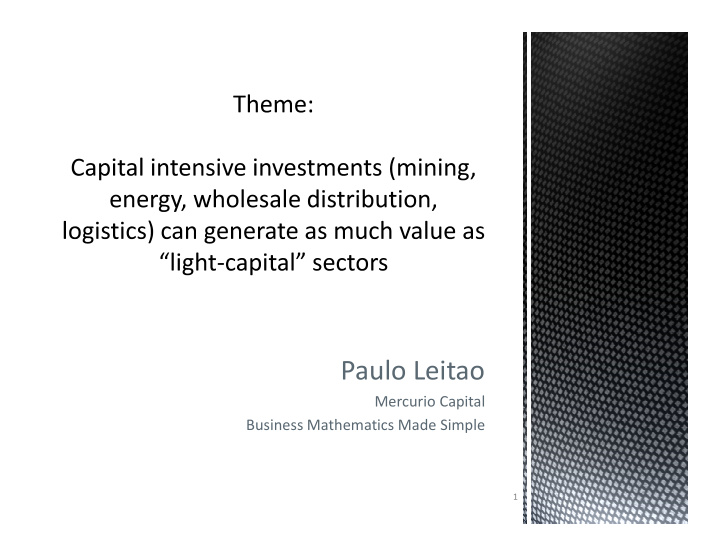



Paulo Leitao Mercurio Capital Business Mathematics Made Simple 1
• (25 -30 minutes presentation) • Overview capital intensive versus “light capital” • Project design • Cost of equity • Valuations • Q&A (20-25 minutes) • I am NOT going to cover: tax, debt costs, complex capital structures 2
� Natural resources make a country rich. � Capital intensive sectors are old-fashioned. � Investors can make more money in digital economy than in heavy industry. � Germany is very successfull with their industrial and manufacturing sector. � UK economy will never have a strong industrial sector. 3
4
� High Capex/ high Opex � Liquidity premium (business plan and business model lack of flexibility) � Sensitivity to country/national risk � High Capex – low Opex// Low Capex – high Opex 5
Liquidity Premium Square root to payback and/or + asset cos t less scrap value project life 1 1 − breakeven in years: (Initial asset cos t investment – salvage value) Country Risk Premiums Economist Intelligence Unit Country Risk destinatio n country score home country score − X 100 % Reports (score system): home country score Standard & Poors 10-year Sovereign bond yield Sovereign 10-year yields 6
40 Licensing Build Operation 35 30 Return 25 Risk 20 15 10 5 0 Time 1 2 3 4 5 6 7 8 9 7
8
•Contracts in •Uncertainty place •Small equity •High capital Build Licensing Operation investments needs •Measure •Equity and Value Drivers! debt secured • Risk •Attention • Risk measured turns to Pre- contracted Value mgt “Feasibility” liquidity • Event feasibility • “Bankable” management driven (ex diligence licences) DCF/ Seed DCF Startup Operation Heuristics Assets 9
There is liquidity in the market! EBITDA multiple Net Income multiples Sales multiples Contract/client-based Default Market Valuation Discounted Cash Flows (DCF) Increase cash flows Decrease risk ------------------------------- Multiples (Terminal values) No liquidity in the market/no cash flows Asset based Probability Heuristics 10
11
� Cost of Equity is the return needed to keep the equity in the company � Intrinsic Risk & External non-controllable variables � Business Risk + Liquidity + Country Risk � Main challenges with Equity: Not visible (not cash/accounting cost) Measured indirectly (Mkt multiples, Quantitative Methods, Benchmarking, Ungeared Beta, etc) For private companies, more difficult to measure 12
Event driven Required Rate of Return 70 60 Seed Build 50 “T” - Technology “TIO” “I” - Implementation 40 “O” - Operation Startup 30 Early 20 Growth Late Expansion IPO 10 Mature 0 Time 1 2 3 4 5 6 7 8 9 10 11 12 13
1 2 3 4 5 6 7 8 9 10 11 12 13 14 15 Licensing Business Build Premium Business Premium Start Up Uncertainty EXIT Sweet Spot BP BP BP BP BP BP BP BP BP BP BP Liquidity LP LP LP LP LP LP Premium Country CP CP CP CP CP CP CP CP CP CP CP Premium 14
� Risk protection (project finance) � Income streams: Futures � Interest rates: Swaps � Currency: Forwards 15
16
Group Impact Capital Budgeting Investment logic & capital structure Management Go/NoGo decision & “Design freeze” 17
� Natural resources make a country rich. � Capital intensive sectors are old-fashioned. � Investors can make more money in digital economy than in heavy industry. � Germany is very successfull with their industrial and manufacturing sector. � UK economy will never have a strong industrial sector. 18
� Mercurio Capital Ltd � www.mercurio-capital.com � Follow us on Twitter! (Business Mathematics) https://twitter.com/MercurioCapital � LinkedIn Group (Business Mathematics Made Simple) 19
Recommend
More recommend